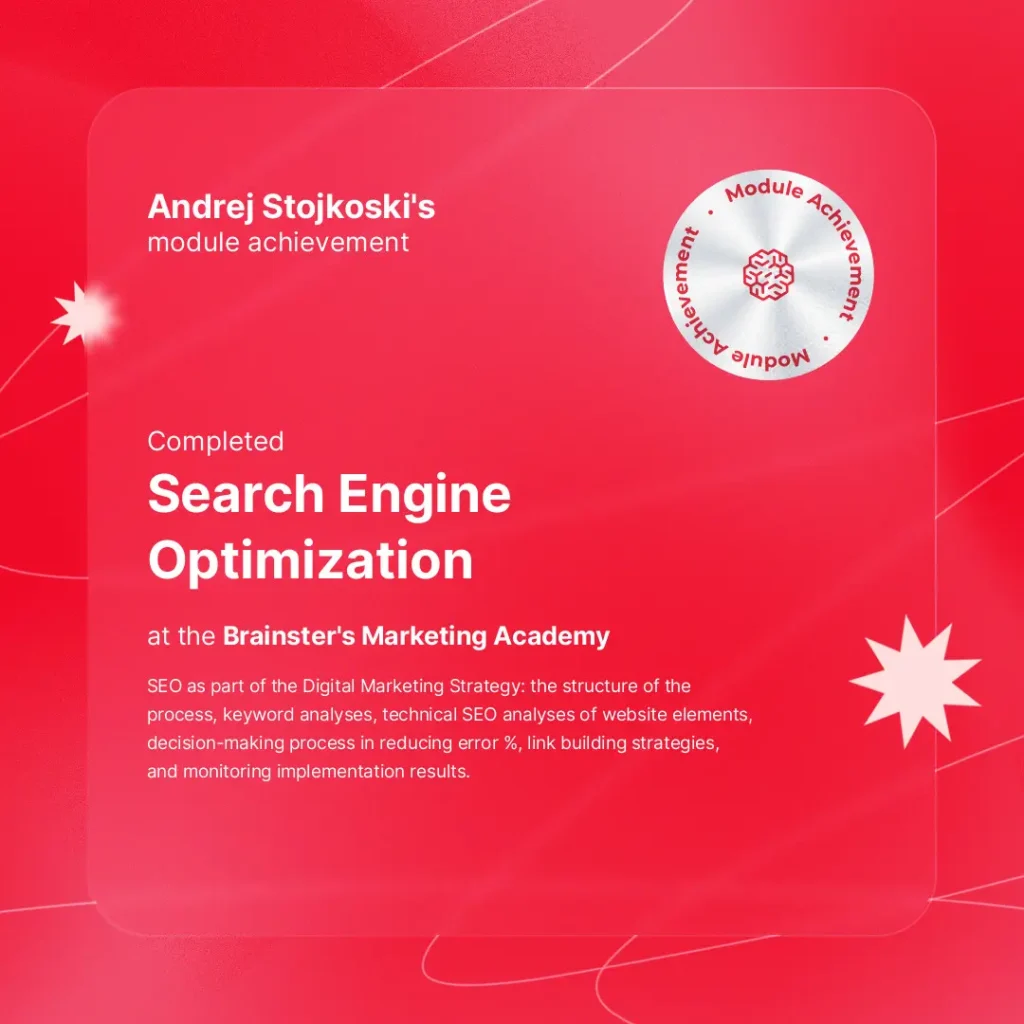Turning Strategy Into Visibility: My SEO Journey After Content Marketing
Following the Content Marketing & Visual Storytelling module, where I developed strategies to attract and engage audiences through storytelling, the next step in my journey at Brainster’s Digital Marketing Academy was mastering how to get that content discovered. That’s where Search Engine Optimization (SEO) came in.
Over three highly practical weeks, the SEO module helped me understand how search engines work, how to speak their language, and how to ensure that the right people discover my content organically. This was the module where strategy truly met visibility.
My Expectations for the SEO Module
Going in, I expected the SEO module to be technical—but also strategic. I hoped to learn how to identify the right keywords, how to audit websites for performance, and how to build backlink strategies without being spammy.
I wanted to build a full-circle skill set: from creating content, to optimizing it for discovery, to ensuring it ranked well over time. And that’s exactly what this module delivered.

What I Learned in the Search Engine Optimization Module
This module was divided into three powerful weeks, each covering a core pillar of Search Engine Optimization: Keyword Analysis, SEO Audit, and Backlink Strategy.
🔹 Week 1: Keyword Analysis – Speaking the Language of Your Audience
We began by understanding how to align business goals with digital strategy through keyword research. Some key takeaways:
- User Behavior & Intent: I learned how to study how our ideal users search online and translate those behaviors into keyword opportunities.
- SEO & Business Strategy: Every SEO action must support business goals. This isn’t guesswork—it’s informed by user needs and strategic alignment.
- Keyword Tools: We used platforms like Google Keyword Planner and Ubersuggest to analyze volume, competition, and relevancy.
Keyword Mapping: I created a keyword document that linked selected keywords to specific landing pages and content areas that needed optimization or creation.
🔹 Week 2: SEO Audit – Fixing What’s Under the Hood
Next, we dug into the technical side of SEO. We performed audits to find and fix what holds websites back from ranking.
What I did:
- Conducted a comprehensive SEO audit, checking everything from page speed to broken links and meta data.
- Identified issues like missing alt text, improper heading structures, and poor mobile responsiveness.
- Developed a document outlining:
- Issues discovered
- Recommended solutions
- Severity ratings
- Team responsibilities (e.g., developers, content creators)
This exercise taught me the value of collaboration—SEO isn’t just for marketers. Developers, designers, and writers all play a role.
🔹 Week 3: Backlink Analysis – Building Domain Authority
Finally, we explored how external websites signal trust to search engines through backlinks. This part was incredibly eye-opening.
Key concepts and practices:
- Backlink Quality over Quantity: One high-quality backlink beats 50 spammy ones.
- Anchor Text Planning: I created a map of anchor phrases aligned with my previously selected keywords and target landing pages.
- Competitor Backlink Research: Using tools like Ahrefs and SEMrush, I explored who was linking to competitors and how to ethically replicate their link profiles.
Backlink Strategy Plan: I documented a step-by-step backlink building roadmap, complete with timelines, anchor variations, and ethical outreach sources.
How I Applied the SEO Module in Practice
For the final project, I created a full SEO strategy including:
- A keyword analysis document tailored to a specific brand’s audience and goals.
- A technical SEO audit with prioritized fixes and estimated resources needed.
- A backlink generation plan with selected sources, anchor texts, and landing page goals.
This project not only tested everything I’d learned, but it also prepared me to step confidently into real-world digital marketing roles that demand SEO understanding.
My Experience with the SEO Module
This was one of the most analytical and rewarding modules I completed. While the previous modules leaned more toward creativity and storytelling, this one exercised my strategic and technical thinking.
I particularly enjoyed:
- Learning how SEO fits into the larger digital marketing puzzle
- The blend of logic and creativity needed for keyword selection
- Understanding how to communicate SEO needs with different teams
Thanks to this module, I now understand that SEO isn’t just about rankings—it’s about making sure the right people find your message at the right time.
Tools and Concepts I Worked With
Tool/Concept | Purpose |
Google Keyword Planner | Researching search trends and keyword volumes |
Ubersuggest / Ahrefs | Competitor analysis and backlink research |
SEO Audit Templates | Diagnosing on-page and technical SEO issues |
Backlink Strategy Docs | Planning link building campaigns ethically |
Keyword Mapping Sheets | Linking keywords to content and landing pages |
Top Skills I Gained from the SEO Module
✅ Keyword Research & Strategy
Identifying what your audience is really searching for—and why.
✅ Technical SEO Understanding
Recognizing website errors and planning collaborative fixes.
✅ Backlink Building
Creating strategies to increase authority and trustworthiness.
✅ SEO Documentation & Communication
Presenting SEO findings and plans in a way that non-technical teams can act on.
Why SEO Is Essential in Today’s Digital Strategy
You can have the best product and content in the world—but if no one can find it, it doesn’t matter. Search Engine Optimization is the long game. It’s how brands build organic visibility, trust, and lasting authority.
It’s not just a tactic—it’s an investment in growth. And now, thanks to this module, it’s a core strength in my marketing toolkit.
Final Thoughts: Visibility Built on Strategy
The Search Engine Optimization module was the perfect follow-up to Content Marketing & Visual Storytelling. It completed the picture: from strategy, to storytelling, to discoverability.
I now approach content with not just creativity, but with structure, strategy, and the knowledge of how to make it rank, resonate, and convert.